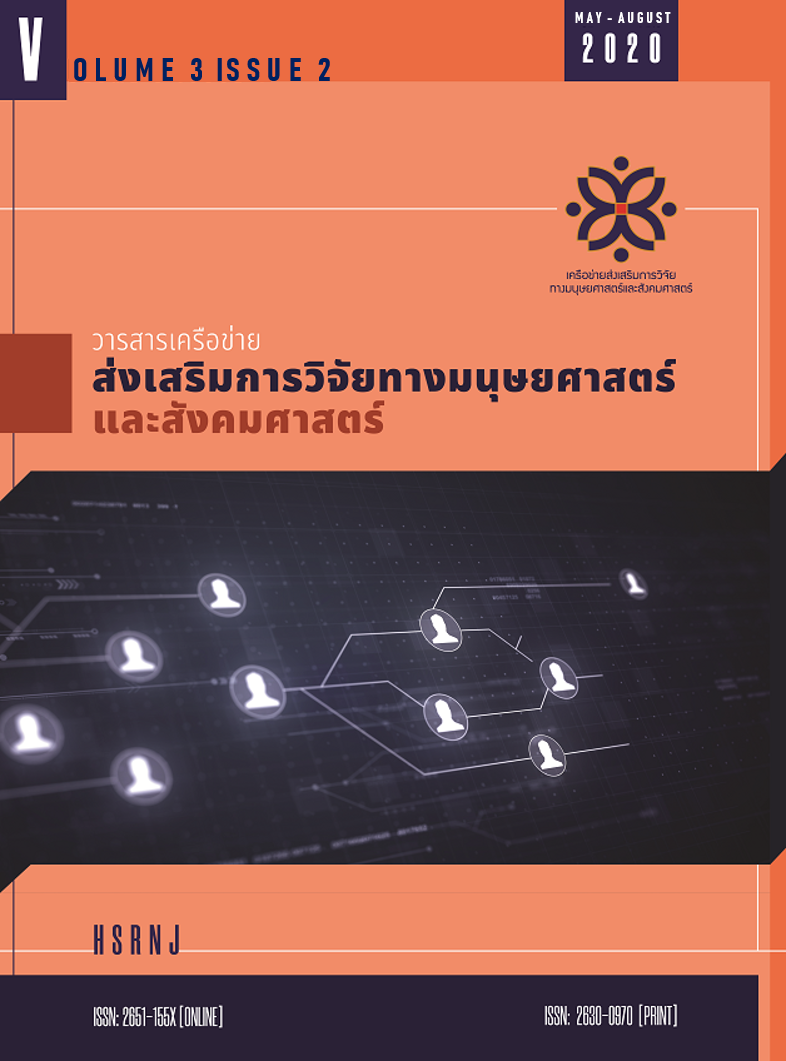ปัจจัยที่ส่งผลต่อการเลือกซื้อสินค้าออนไลน์ของลูกค้าชาวไทย
คำสำคัญ:
พฤติกรรมการเลือกซื้อสินค้าออนไลน์, ทัศนคติในการซื้อสินค้าออนไลน์, ความตั้งใจเลือกซื้อสินค้าออนไลน์บทคัดย่อ
การศึกษาครั้งนี้มีวัตถุประสงค์เพื่อ 1) เปรียบเทียบความตั้งใจเลือกซื้อของลูกค้าที่ซื้อสินค้าออนไลน์จำแนกตามปัจจัยส่วนบุคคล 2) ศึกษาอิทธิพลของพฤติกรรมการเลือกซื้อสินค้าออนไลน์ที่มีผลต่อทัศนคติ ในการเลือกซื้อของลูกค้าที่ซื้อสินค้าออนไลน์ และ 3) ศึกษาอิทธิพลของทัศนคติในการเลือกซื้อสินค้าที่มีผลต่อความตั้งใจเลือกซื้อของลูกค้าที่ซื้อสินค้าออนไลน์ กลุ่มตัวอย่างที่ใช้ในการศึกษา คือ ประชาชนที่มีการซื้อสินค้าออนไลน์ จำนวน 400 คน โดยใช้แบบสอบถามในการเก็บข้อมูลด้วยวิธีการสุ่มตามความสะดวก ในการวิเคราะห์ข้อมูล ผู้วิจัยใช้สถิติความถี่ ร้อยละ ค่าเฉลี่ย ส่วนเบี่ยงเบนมาตรฐาน การทดสอบความแตกต่างของค่าเฉลี่ย การทดสอบความแปรปรวนทางเดียว การวิเคราะห์การถดถอยอย่างง่าย และการวิเคราะห์ การถดถอยเชิงพหุคูณแบบขั้นตอน ผลการศึกษาพบว่า ลูกค้าที่ซื้อสินค้าออนไลน์ที่มีเพศ รายได้ต่อเดือน ระยะเวลาในการซื้อสินค้าออนไลน์ต่อวัน และจำนวนครั้งที่ซื้อออนไลน์ในปีปัจจุบันนี้แตกต่างกัน มีความคิดเห็นเกี่ยวกับความตั้งใจเลือกซื้อของลูกค้าที่ซื้อสินค้าออนไลน์ต่างกัน นอกจากนี้ พฤติกรรมการเลือกซื้อสินค้าออนไลน์ด้านการรับรู้ความเสี่ยง ด้านการรับรู้ความง่าย ด้านการรับรู้ประโยชน์ และด้านประสบการณ์ มีอิทธิผลต่อทัศนคติในการซื้อสินค้าออนไลน์ของลูกค้าที่ซื้อสินค้าออนไลน์ สุดท้าย ทัศนคติในการซื้อสินค้าออนไลน์มีอิทธิผลต่อความตั้งใจเลือกซื้อของลูกค้าที่ซื้อสินค้าออนไลน์ อย่างมีนัยสำคัญทางสถิติที่ระดับ 0.05
เอกสารอ้างอิง
Alan, A. K., Kabadayı, E. T., Bakis, S., & Ildokuz, S. I. (2017). The role of individual factors on online shopping behavior. Journal of Business Economics and Finance, 6(3), 200-215.
Chanthinok, K. (2015). Why does the consumer online purchasing? a conceptual model of social factors. Social Science Asia, 1(3), 1-15.
Cochran. W.G. (1977). Sampling Techniques 3rd edition. New York: John Wiley & Sons.
Davis, F. D. (1989). Perceived usefulness, perceived ease of use, and user acceptance of information technology. MIS quarterly, 13(3), 319-340.
Doolin, B., Dillon, S., Thompson, F., & Corner, J. L. (2005). Perceived risk, the Internet shopping experience and online purchasing behavior: A New Zealand perspective. Journal of Global Information Management, 13(2), 66-88.
Forsythe, S. M., & Shi, B. (2003). Consumer patronage and risk perceptions in Internet shopping. Journal of Business research, 56(11), 867-875.
Inkaew, A., & Huang, C. Y. (2019). Exploring consumer behavior of Thai millennials towards buying consumer electronics online. RMUTT Global Business Accounting and Finance Review, 3(3), 1-12.
Jiradilok, T., Malisuwan, S., Madan, N., & Sivaraks, J. (2014). The impact of customer satisfaction on online purchasing: A case study analysis in Thailand. Journal of Economics, Business and Management, 2(1), 5-11.
Hajiar, S. T. (2014). A statistical study to develop a reliable scale to evaluate instructors within higher institution. WSEAS Transactions on Mathematics, 13, 885-894.
Katawetawaraks, C., & Wang, C. (2011). Online shopper behavior: Influences of online shopping decision. Asian Journal of Business Research, 1(2), 66-74.
Klopping, I. M., & McKinney, E. (2004). Extending the technology acceptance model and the task-technology fit model to consumer e-commerce. Information Technology, Learning & Performance Journal, 22(1), 35-48.
Laosethakul, K., & Boulton, W. (2007). Critical Success Factors for E‐commerce in Thailand: Cultural and Infrastructural Influences. The Electronic Journal of Information Systems in Developing Countries, 30(1), 1-22.
Naseri, M. B., & Elliott, G. (2011). Role of demographics, social connectedness and prior internet experience in adoption of online shopping: Applications for direct marketing. Journal of Targeting, Measurement and Analysis for Marketing, 19(2), 69-84.
Niranjanamurthy, M., Kavyashree, N., Jagannath, S., & Chahar, D. (2013). Analysis of e-commerce and m-commerce: advantages, limitations and security issues. International Journal of Advanced Research in Computer and Communication Engineering, 2(6), 2360-2370.
Prashar, S., Sai Vijay, T., & Parsad, C. (2017). Effects of online shopping values and website cues on purchase behaviour: A study using S–O–R framework. Vikalpa, 42(1), 1-18.
Rayburn, J. M., & Conrad, C. (2004). China’s Internet structure: Problems and control measures. International Journal of Management, 21(4), 471-480.
Weihai, Y., Bingqiong, H., & Lihong, W. (2015). Review of International Symposium of" Socialism Genre". Socialism Studies, (6), 19.
Zanella, A., Bui, N., Castellani, A., Vangelista, L., & Zorzi, M. (2014). Internet of things for smart cities. IEEE Internet of Things journal, 1(1), 22-32.
ดาวน์โหลด
เผยแพร่แล้ว
รูปแบบการอ้างอิง
ฉบับ
ประเภทบทความ
สัญญาอนุญาต
บทความที่ได้รับการตีพิมพ์เป็นลิขสิทธิ์ของ ผู้เขียน
ทัศนะและความคิดเห็นที่ปรากฏในบทความในวารสารเครือข่ายส่งเสริมการวิจัยทางมนุษยศาสตร์และสังคมศาสตร์จะถือเป็นความรับผิดชอบของผู้เขียนบทความนั้น และไม่ถือเป็นทัศนะและความรับผิดชอบของกองบรรณาธิการ








